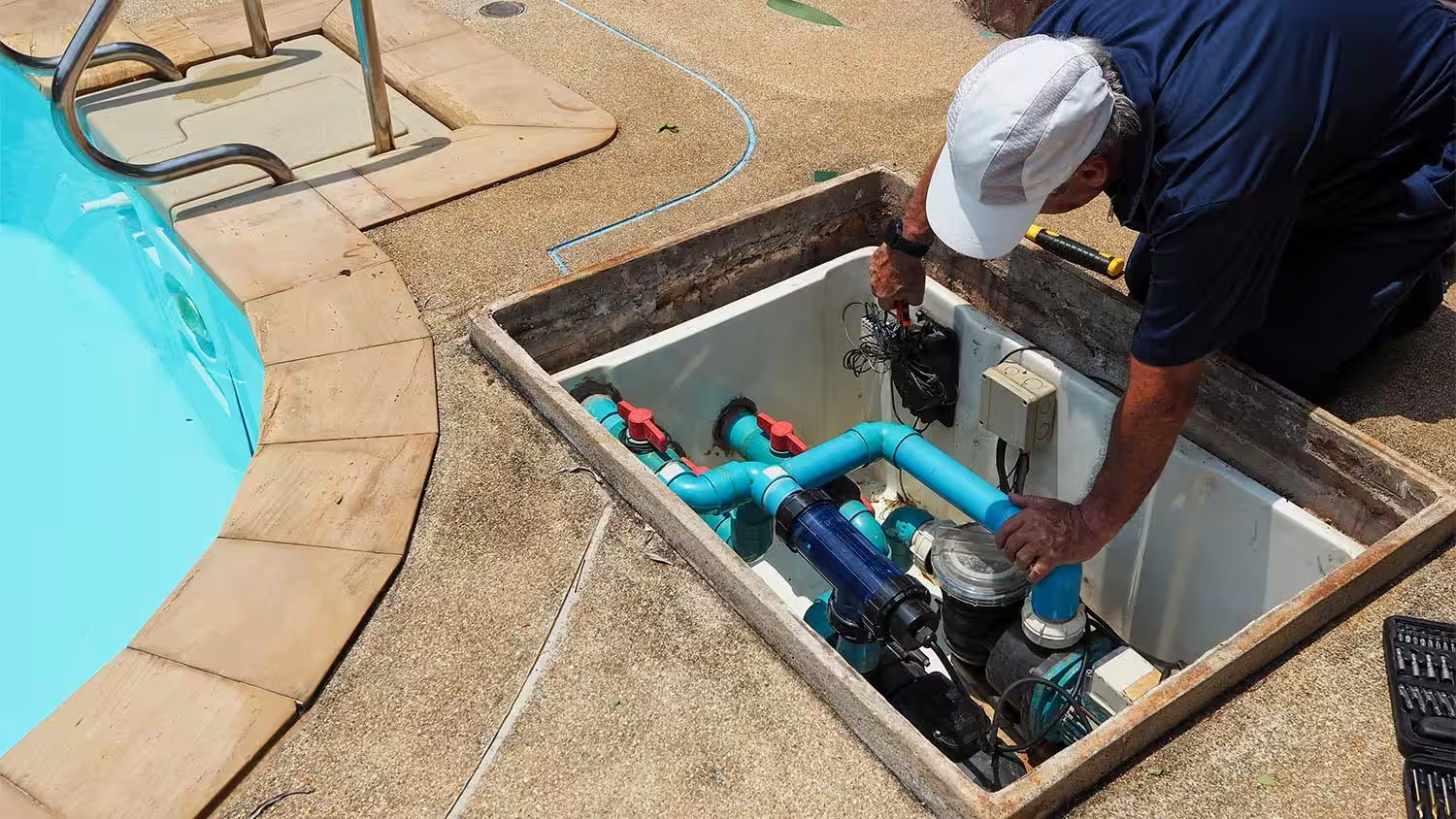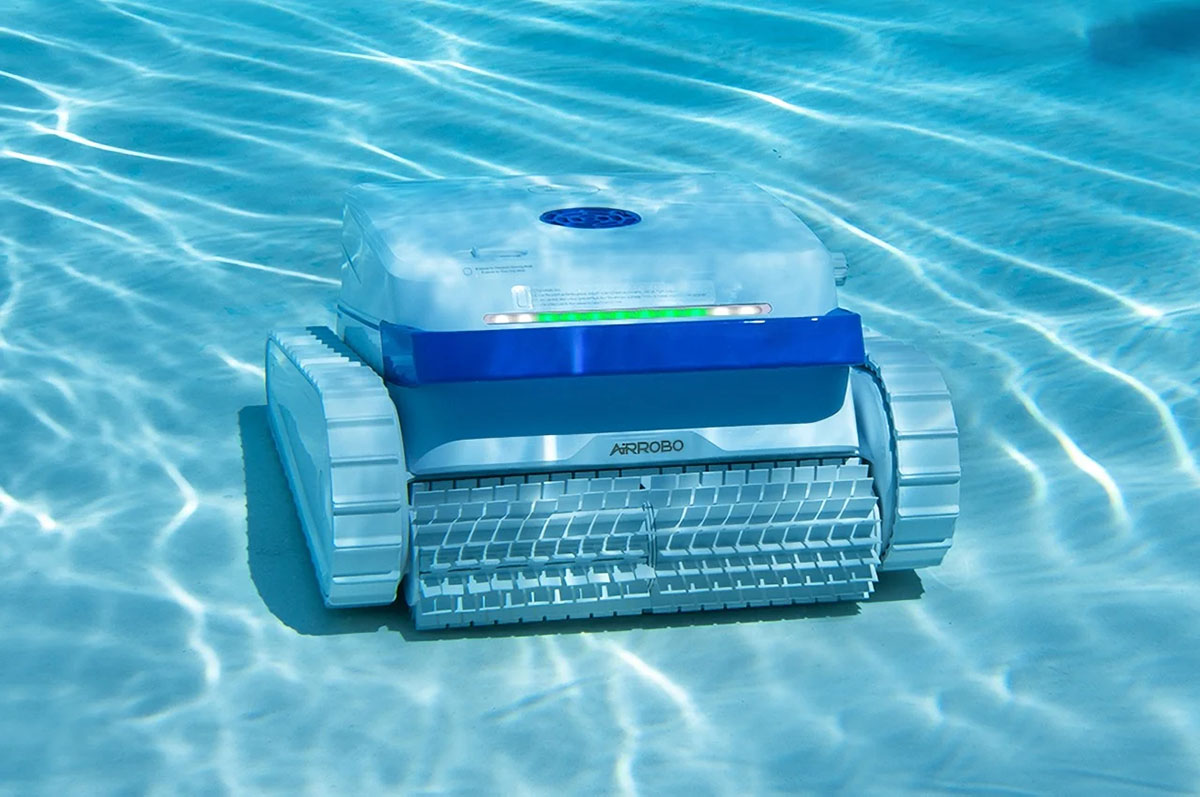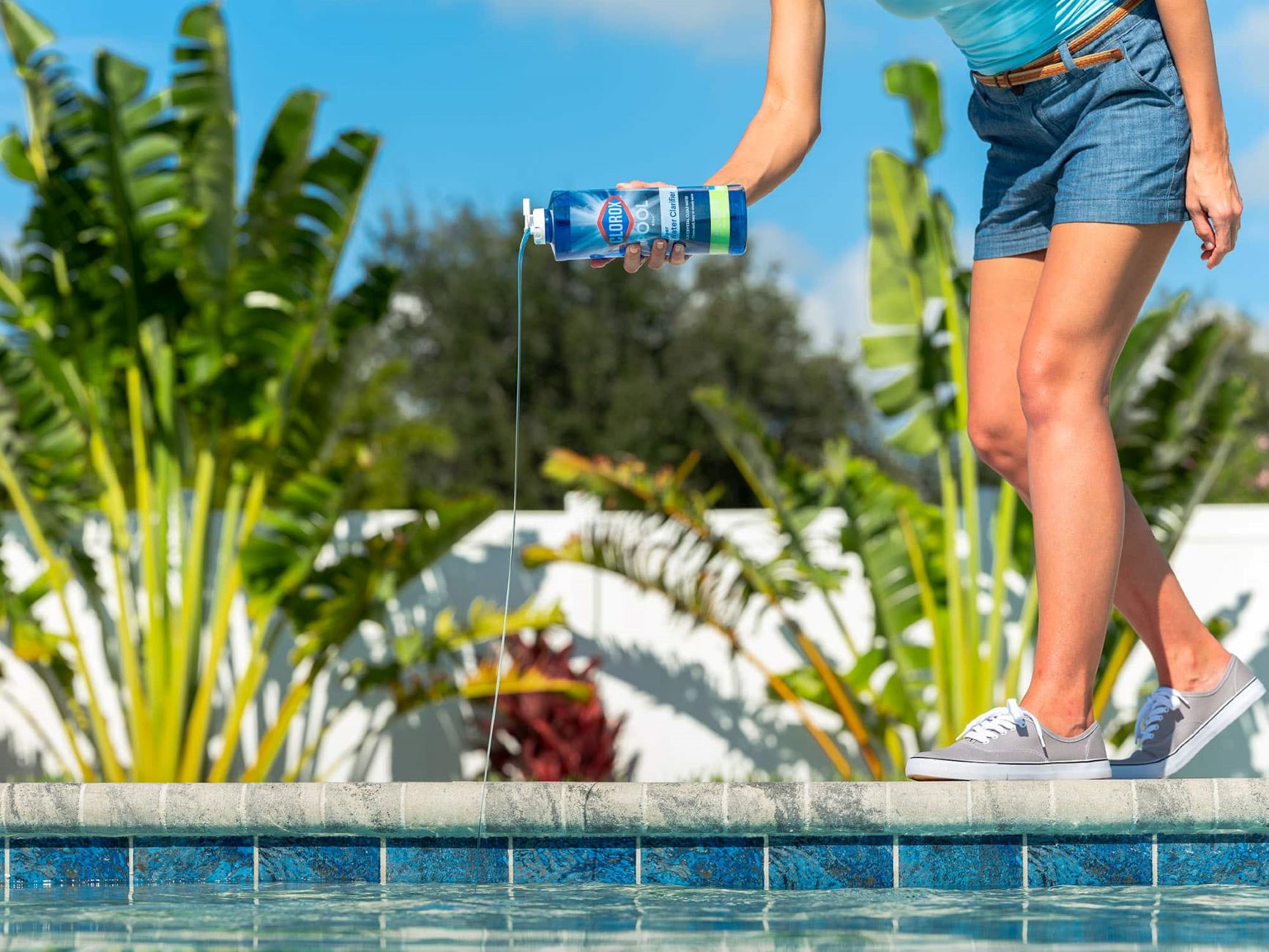Home>Gardening & Outdoor>Outdoor Recreation & Activities>How Does A Swimming Pool Pump Work


Outdoor Recreation & Activities
How Does A Swimming Pool Pump Work
Published: February 18, 2024
Learn how a swimming pool pump works and keeps your pool clean and safe. Discover the essential outdoor recreation and activities for maintaining a healthy pool.
(Many of the links in this article redirect to a specific reviewed product. Your purchase of these products through affiliate links helps to generate commission for Storables.com, at no extra cost. Learn more)
Introduction
A swimming pool pump is a vital component of any pool system, playing a crucial role in maintaining water circulation and filtration. Understanding how a swimming pool pump works is essential for pool owners and maintenance professionals alike. By comprehending the basic components and operational principles of a pool pump, individuals can make informed decisions about pump selection, maintenance, and troubleshooting.
A well-functioning pool pump ensures that the water in the pool remains clean, clear, and safe for swimming. It achieves this by circulating the water through the filtration system, removing debris, dirt, and other impurities. Additionally, the pump facilitates the distribution of pool chemicals, such as chlorine, to effectively sanitize the water. Without a properly functioning pump, the pool water can become stagnant, leading to the growth of algae and harmful bacteria.
In this comprehensive guide, we will delve into the inner workings of a swimming pool pump, exploring its basic components, operational mechanisms, different types available, and essential factors to consider when selecting the right pump for your pool. Whether you are a new pool owner or a seasoned professional seeking to enhance your knowledge, this article will provide valuable insights into the functionality and significance of swimming pool pumps.
Understanding the intricacies of a swimming pool pump empowers individuals to make informed decisions regarding maintenance, repairs, and upgrades. By gaining a deeper understanding of how these essential components operate, pool owners can optimize the performance of their pool systems, ensuring clean, healthy, and inviting swimming environments for years to come.
Key Takeaways:
- Keep your pool clean and safe by understanding how a swimming pool pump works. It circulates and filters water, preventing algae and bacteria growth. Choose the right pump for a healthy swimming environment.
- Consider factors like pool size, energy efficiency, and noise level when choosing a swimming pool pump. Make an informed decision to optimize water circulation and minimize energy consumption.
Read more: How Does A Swimming Pool Filter Work
Basic Components of a Swimming Pool Pump
A swimming pool pump consists of several essential components that work together to facilitate the circulation and filtration of pool water. Understanding these basic elements is crucial for comprehending the overall functionality of the pump.
-
Motor: At the heart of every swimming pool pump is the motor, which serves as the powerhouse driving the entire operation. Typically powered by electricity, the motor generates the necessary energy to propel water through the pump and filtration system. The motor's horsepower (HP) rating determines its capacity to move water, with higher HP motors being suitable for larger pools or those with additional features such as waterfalls or spa jets.
-
Impeller: Connected to the motor shaft, the impeller is a rotating component responsible for creating the necessary suction and pressure to draw water into the pump and expel it through the filtration system. As the impeller spins, it generates centrifugal force, effectively pushing water through the pump and into the filtration unit.
-
Housing or Pump Body: The housing, also known as the pump body, encases the motor and impeller, providing structural support and protection. It also contains the inlet and outlet ports through which water enters and exits the pump. The housing is designed to withstand the pressures and forces exerted during the pumping process, ensuring the pump's durability and longevity.
-
Strainer Basket: Positioned within the pump housing, the strainer basket serves as a critical filtration component, capturing large debris and foreign objects before they enter the pump. This helps prevent clogging and damage to the impeller and other internal parts. Regular cleaning of the strainer basket is essential to maintain optimal pump performance.
-
Lid and O-Ring: The pump housing is equipped with a lid secured by an O-ring, creating a watertight seal. This seal prevents air from entering the system and ensures that water is effectively drawn into the pump. Proper maintenance of the O-ring, including regular lubrication and inspection for wear and tear, is essential to prevent leaks and maintain efficient pump operation.
Understanding the basic components of a swimming pool pump provides valuable insight into the intricate mechanisms that drive water circulation and filtration. Each component plays a crucial role in ensuring the pump's functionality and efficiency, ultimately contributing to the overall cleanliness and clarity of the pool water.
How a Swimming Pool Pump Works
A swimming pool pump operates through a series of carefully orchestrated steps, each essential for maintaining optimal water circulation and filtration. Understanding the inner workings of a pool pump provides valuable insight into its functionality and significance in preserving clean and healthy pool water.
The process begins with the activation of the pump's motor, which generates the necessary energy to drive the entire operation. As the motor powers up, the impeller, a rotating component connected to the motor shaft, begins to spin. This rotational motion creates centrifugal force, effectively drawing water into the pump through the inlet port.
Upon entering the pump, the water encounters the strainer basket, a critical filtration component positioned within the pump housing. The strainer basket captures large debris, leaves, and other foreign objects, preventing them from entering the pump and potentially causing damage to the internal components. Regular cleaning of the strainer basket is essential to maintain unobstructed water flow and prevent clogging.
Once the water passes through the strainer basket, it is propelled towards the impeller, which further accelerates its movement through the pump. The impeller's spinning action generates pressure, pushing the water through the pump and into the filtration system. This pressurized flow ensures that the water is effectively circulated and filtered, removing impurities and maintaining water clarity.
As the water exits the pump, it enters the filtration unit, where it undergoes thorough cleaning and purification. The filtration system, which may consist of sand, cartridge, or diatomaceous earth filters, captures finer particles and contaminants, ensuring that the water is free from debris and impurities.
Following filtration, the clean water is returned to the pool through the outlet port, completing the circulation cycle. The continuous operation of the pump ensures that the water remains in motion, preventing stagnation and facilitating the distribution of pool chemicals, such as chlorine, for effective sanitation.
In essence, a swimming pool pump works by harnessing the power of its motor to drive water circulation and filtration. The coordinated efforts of the motor, impeller, housing, strainer basket, and filtration system ensure that the pool water remains clean, clear, and inviting for swimmers. By comprehending the operational mechanisms of a pool pump, individuals can appreciate its vital role in maintaining a healthy and enjoyable swimming environment.
Types of Swimming Pool Pumps
When it comes to swimming pool pumps, various types are available, each designed to meet specific performance needs and operational requirements. Understanding the distinctions between these pump varieties is essential for selecting the most suitable option for a particular pool system. Here are the primary types of swimming pool pumps:
Single-Speed Pumps
Single-speed pumps are the traditional and most common type of pool pumps. They operate at a constant speed, typically at the highest horsepower available for the motor. While single-speed pumps are effective at circulating and filtering pool water, they are known for their relatively high energy consumption. Despite their efficiency in maintaining water clarity, these pumps are not as energy-efficient as their variable-speed counterparts.
Read more: How Does A Swimming Pool Heat Pump Work
Variable-Speed Pumps
Variable-speed pumps offer a more energy-efficient alternative to single-speed pumps. These pumps allow users to adjust the motor speed, enabling them to operate at different RPMs (revolutions per minute). By varying the speed based on specific circulation and filtration needs, variable-speed pumps can significantly reduce energy consumption, resulting in lower utility costs. Additionally, these pumps provide quieter operation and longer lifespan due to reduced wear and tear on the motor.
Dual-Speed Pumps
Dual-speed pumps combine the features of single-speed and variable-speed pumps, offering two speed settings for enhanced flexibility. Pool owners can choose between high and low-speed settings, allowing them to optimize energy efficiency based on their pool's requirements. While dual-speed pumps are more energy-efficient than single-speed pumps, they may not offer the same level of energy savings as variable-speed pumps. However, they provide a middle ground for individuals seeking a balance between energy efficiency and upfront cost.
Energy-Efficient Pumps
Energy-efficient pumps encompass a range of pump types designed to minimize energy consumption while maintaining optimal performance. These pumps often incorporate advanced motor technologies, such as permanent magnet motors, to achieve higher efficiency levels. By investing in an energy-efficient pump, pool owners can reduce their environmental impact and operating costs while enjoying reliable water circulation and filtration.
Specialty Pumps
In addition to the standard pump types, specialty pumps cater to specific pool features and requirements. These may include booster pumps for pressure-side pool cleaners, circulation pumps for spas and water features, and waterfall pumps for decorative water elements. Specialty pumps are tailored to meet unique circulation and hydraulic needs, enhancing the functionality and aesthetics of pool systems with specialized features.
Understanding the characteristics and capabilities of each type of swimming pool pump is crucial for making informed decisions when selecting a pump for a pool system. By considering factors such as energy efficiency, operational flexibility, and specific pool requirements, individuals can choose a pump that aligns with their performance expectations and sustainability goals.
Read more: How Does A Swimming Pool Sand Filter Work
Factors to Consider When Choosing a Swimming Pool Pump
When selecting a swimming pool pump, several crucial factors should be taken into account to ensure optimal performance, energy efficiency, and compatibility with the pool system. By carefully considering these factors, pool owners can make informed decisions that align with their specific needs and sustainability goals.
Pool Size and Volume
The size and volume of the pool play a significant role in determining the appropriate pump size and capacity. Larger pools with greater water volume require pumps with higher horsepower to effectively circulate and filter the water. Conversely, smaller pools may benefit from smaller, more energy-efficient pumps that can adequately meet their circulation needs without unnecessary energy consumption.
Flow Rate and Turnover Rate
Understanding the desired flow rate and turnover rate for the pool is essential when choosing a pump. The flow rate refers to the volume of water circulated by the pump within a specific time, typically measured in gallons per minute (GPM). The turnover rate indicates how quickly the pump can cycle the entire pool water volume through the filtration system. By aligning the pump's flow rate and turnover rate with the pool's requirements, optimal water circulation and filtration can be achieved.
Energy Efficiency
Energy-efficient pumps, such as variable-speed or dual-speed models, offer significant long-term cost savings and environmental benefits. These pumps allow for adjustable motor speeds, enabling users to match the pump's performance with the pool's needs, thereby reducing energy consumption. When choosing a pool pump, prioritizing energy efficiency can lead to lower utility bills and a reduced carbon footprint.
Read more: Swimming Pool Heat Exchanger: How It Works
Filtration System Compatibility
The pump selected should be compatible with the pool's filtration system, including the type of filter being used. Whether the pool utilizes sand, cartridge, or diatomaceous earth filters, the pump's flow rate and pressure must align with the filtration system's requirements to ensure effective filtration and maintenance of water clarity.
Noise Level and Operation
Consideration should be given to the noise level and overall operation of the pump. Variable-speed pumps, known for their quieter operation at lower speeds, offer a more tranquil pool environment compared to traditional single-speed pumps. Evaluating the pump's noise level and operational characteristics can contribute to a more enjoyable and peaceful swimming experience.
Long-Term Maintenance and Durability
Assessing the long-term maintenance requirements and durability of the pump is crucial for minimizing upkeep costs and ensuring reliable performance. Pumps with durable construction, easily accessible components for maintenance, and reliable seals and gaskets can contribute to long-term operational efficiency and cost-effectiveness.
Environmental Impact
Considering the environmental impact of the pump, including its energy consumption and overall sustainability, is increasingly important. Energy-efficient pumps with advanced motor technologies can significantly reduce the pool's carbon footprint while maintaining optimal water circulation and filtration.
By carefully evaluating these factors, pool owners can make well-informed decisions when choosing a swimming pool pump, ultimately contributing to a more sustainable, cost-effective, and enjoyable pool ownership experience.
Read more: How Does Pool Plumbing Work
Conclusion
In conclusion, a swimming pool pump is a fundamental component of any pool system, playing a pivotal role in maintaining water circulation, filtration, and overall water quality. Understanding the inner workings of a pool pump, including its basic components, operational mechanisms, and various types available, is essential for pool owners and maintenance professionals alike.
By comprehending the significance of the motor, impeller, housing, strainer basket, and filtration system within a pool pump, individuals gain valuable insights into the intricate processes that contribute to clean and healthy pool water. The coordinated efforts of these components ensure that the water remains in constant motion, preventing stagnation and facilitating the removal of debris and impurities.
Furthermore, the availability of different types of swimming pool pumps, including single-speed, variable-speed, dual-speed, energy-efficient, and specialty pumps, offers diverse options to meet specific performance needs and sustainability goals. Pool owners can make informed decisions based on factors such as pool size, flow rate, energy efficiency, filtration system compatibility, noise level, long-term maintenance, durability, and environmental impact.
Ultimately, selecting the right swimming pool pump is crucial for optimizing water circulation, maintaining water clarity, and minimizing energy consumption. By considering the factors outlined in this guide, individuals can make well-informed decisions that align with their pool's requirements and sustainability objectives.
In essence, a well-maintained and properly selected swimming pool pump contributes to a clean, clear, and inviting swimming environment, enhancing the overall enjoyment and satisfaction of pool ownership. With a deeper understanding of how a swimming pool pump works and the factors to consider when choosing one, individuals can confidently maintain their pool systems, ensuring a safe and enjoyable swimming experience for years to come.
Frequently Asked Questions about How Does A Swimming Pool Pump Work
Was this page helpful?
At Storables.com, we guarantee accurate and reliable information. Our content, validated by Expert Board Contributors, is crafted following stringent Editorial Policies. We're committed to providing you with well-researched, expert-backed insights for all your informational needs.












0 thoughts on “How Does A Swimming Pool Pump Work”